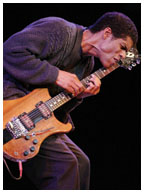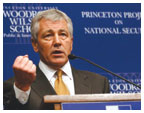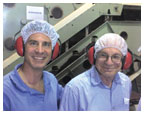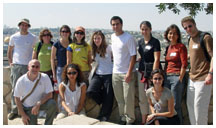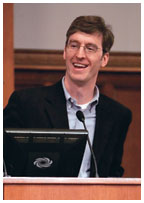
|
October 25, 2006: Notebook
For black alumni, a chance to reconnect
Celebrating Nassau Hall’s 250th
Professor cites e-voting flaws
A bold plan for national security
Money, happiness, and how we spend our time
Before the lectures, a firsthand look at Jerusalem
Participants in the black alumni conference gather for a group portrait at Clio Hall. (Elizabeth Greenberg ’02)
Jazz guitarist Stanley Jordan ’81 in concert at Alexander Hall. (Frank Wojciechowski) |
For black alumni, a chance to reconnect
What was going on?
There, standing on the white marble steps of Clio Hall, were rows and rows of smartly dressed black men and women, laughing, hugging, and playfully chiding those few stragglers who had to sprint to take their places in the giddy throng. As they all paused to smile into the camera, it was impossible not to think of “A Great Day in Harlem,” Art Kane’s 1958 photo showing 57 members of the jazz aristocracy spilling down the steps of a Harlem brownstone and onto the street below.
This was a great day, too, and not just for the 530 black alumni who gathered on the last weekend of September for “Coming Back and Looking Forward,” the first conference for black Princeton alumni. For the rest of the University community, it signaled a fresh start to a relationship that never has been as warm as it should be.
“I was personally angry at this university,” said Brian Stephenson ’78, who owns a civil engineering firm in Baltimore and also serves as an adjunct professor at Howard University. “It took me several years before I could turn around and say I appreciated the University. I came [to the conference] because I felt something was going to happen, something exciting.”
Stephenson was not alone in feeling, by the end of the weekend, that something exciting had transpired. Indeed, if there was a trajectory to the conference — which began Thursday night and ran through two full days of seminars, lectures, and panel discussions before ending Saturday night with a concert by jazz guitar wizard Stanley Jordan ’81 — it was from a wary, wait-and-see skepticism to a belief that Princeton really had changed. As Janet Dickerson, the University’s vice president for campus life, put it at dinner on Saturday night, “This is not your grandfather’s Princeton!”
The conference was the culmination of several years of talks between Ken Bruce ’83, the outgoing president of the Association of Black Princeton Alumni, and Alumni Association director Margaret Moore Miller ’80. A few years ago they agreed to try to re-engage the University’s 3,800 black alumni, who consistently have been underrepresented at both Alumni Day and Reunions. They contemplated rolling this event into a larger gathering of all minority alumni, but decided to keep the focus narrow since, as Denise Burgess ’84 said, “Our experience here is different from other minorities because of the history of black people here.” In case anyone missed the point, Sharon Bailey ’75 noted that “the first blacks who came to Princeton came to serve the privileged classes, as maids, chauffeurs, and servants.” The history of blacks at Princeton was set out in Looking Back: Reflections of Black Princeton Alumni, a 75-minute documentary by Melvin McCray ’74, who spent the weekend with a camera crew updating the 1996 film.
“What I was hoping would come out of this [conference] is for African-Americans to see that it’s a new day at Princeton,” said Kevin Williams ’83, a psychologist from Alexandria, Va., who helped plan the weekend. He attributed the change to President Tilghman and the appointment of women to key leadership positions. “Women understand how we feel. They were complaining about the same things we were complaining about: Where were the women professors? Where were the African-American professors?”
Tilghman got high marks for reaching out to black alumni. All weekend there was a sense that a bargain was being struck. “I want you coming back on a regular basis,” Tilghman told the gathering, “and looking at our faculty and questioning our students and asking, ‘Are we proceeding in this very important goal we are setting?’”
This was the largest gathering of black alumni ever on the Princeton campus. Along with the usual Ivy power-broker types — doctors, academics, lawyers, and investment people — there were people like Eve Thompson ’82, who helped rewrite South Africa’s constitution, and Thabi Mthombeni-Njenga ’96, who was born under apartheid and now serves as associate ombudsperson at Columbia University.
Invoking the spirit of sankofa, an Akan word that means “going forward while looking backward,” they asked about mentoring, black faculty recruitment, and fundraising. They pondered not only how to improve Princeton and the experience of its black students, but also how the University and its research capabilities might be used to help the wider black community. Burgess was dismayed by what she heard at a panel of students. “You all seem to be interacting with each other and interacting very heavily with black groups,” she told the students. “How much are you interacting with white groups?”
By the end of the weekend, there was a growing consensus that the enthusiasm should be turned into concrete actions. There was a host of ideas, many reflecting an awareness that, as impressive as it was to have so many black faces back at Princeton, some alumni still felt alienated enough to refuse to attend. Elliott Lee ’74 proposed endowing a chair of African-American studies in the name of Bob Rivers ’53, who, as the oldest black alumnus present, spent the weekend posing for photos with younger alumni to whom he was clearly something of a hero.
Cornel West *80, the Class of 1943 University Professor of Religion,
gave a concluding address about black resilience, courage, and humor that
felt more like a revival meeting than a lecture and had his audience stomping
and cheering. Then it was on to Alexander Hall to hear guitarist Stanley
Jordan, perhaps the only person whose fingers are as fast as West’s
words. ![]()
By Merrell Noden ’78
Merrell Noden ’78, a freelance writer, is a frequent PAW contributor.

The original Nassau Hall, depicted in a 1764 print, comprised the entire college; only the president had his own home (today Maclean House), at right. The University is marking 250 years in Princeton with a series of events. |
Celebrating Nassau Hall’s 250th
In November 1756, the College of New Jersey, with its 70 students, three instructors, and President Aaron Burr Sr., took residence at an impressive new home, Nassau Hall — then the largest stone building in the American colonies. On Oct. 28, to celebrate the 250th anniversary of that momentous relocation from Newark, the University plans to re-create glimpses of life at the College and in Princeton during colonial and revolutionary times.
Visitors will be able to interact with historical interpreters in the roles of Dr. Benjamin Rush, Class of 1760, and John Witherspoon, who became Princeton’s president in 1768. Children will explore early American vocations such as silversmithing, printing, and weaving, and play with colonial toys. A local house tour, led by the Princeton Historical Society, will visit the campus’s first two buildings — Nassau Hall and Maclean House — as well as other 18th-century buildings in town.
“Revolutionary Princeton Day” is part of a series of anniversary events scheduled through Nov. 4 that were planned with both town and gown in mind, according to Karen Woodbridge, the University’s director of community relations. “Yes, it’s 250 years of Nassau Hall and Maclean House, but it’s also 250 years of the college being in the town of Princeton,” she said. “We wanted to celebrate that and invite the community to be part of that.”
At the Frist Campus Center, an exhibit of artifacts from Nassau Hall,
including stones from the original structure, will be on display through
Nov. 30. A detailed schedule, with information about lectures on campus
history, is available online at web.princeton.edu/sites/pucra/.
![]()
By B.T.
Who designed Nassau Hall?
In addition to being scarred by Revolutionary War cannonballs and charred by two major fires, Nassau Hall has been shaped and reshaped by several architects. William Shippen and Robert Smith are credited with the original colonial design. Benjamin Latrobe rebuilt the college in the federal style after fire gutted the interior in 1802. John Notman made changes to the initial layout following the second severe fire in 1855, expanding the faculty room and adding staircases to the ends of the building, topped by ornate, Italian-style belvedere towers. The towers — nicknamed “pepper pots” by undergraduates — were removed in 1905 at the behest of trustee Moses Taylor Pyne, Class of 1877.

Professor cites e-voting flaws
In a paper and video presented online in September, computer science professor Edward Felten and graduate students Ariel Feldman and Alex Halderman ’03 exposed vulnerabilities in an electronic voting machine similar to the ones to be used in many elections this fall. Using a hotel mini-bar key and a corrupted memory card, the researchers manipulated the machine and, in turn, changed the outcome of a fictional election.
Within three weeks, Felten was on Capitol Hill, demonstrating his findings to representatives and urging reform in e-voting. A bill to establish a voter-verified paper trail for e-votes, proposed by Princeton-area Rep. Rush Holt, D-N.J., ultimately stalled in the House, but Congress may revisit the topic in its next session. Felten noted that New Jersey lawmakers have addressed the issue, requiring a paper record for electronic voting as of 2008.
Fraud in electronic voting is particularly dangerous, Felten said, because it can spread from machine to machine through computer networks. “Potentially, someone could get access to just one machine and steal an almost unlimited number of votes,” he said.
Many computer scientists are interested in e-voting technology, according to Felten, but few have access to voting machines because manufacturers’ contracts prohibit states and municipalities from allowing independent researchers to inspect the machines. Felten’s lab received its machine, a Diebold AccuVote-TS, from an anonymous private donor.
Felten, the director of Princeton’s Center for Information Technology
Policy, is an advocate for the “freedom to tinker” (also the
title of his blog, www.freedom-to-tinker.com). He said that he plans to
continue studying e-voting, provided he can get access to voting machines
using legal and ethical means. ![]()
By B.T.

The Princeton report offers a “new kind of thinking,” Sen. Chuck Hagel, R-Neb, said in Washington. (Sameer Khan, courtesy Woodrow Wilson School) |
A bold plan for national security
Standing before a packed Senate committee room Sept. 27 on Capitol Hill, Woodrow Wilson School Dean Anne-Marie Slaughter ’80 unveiled an admittedly ambitious document: a 90-page book laying out a framework for America’s engagement with the world over the next century.
The product of 21/2 years of meetings with nearly 400 experts, “Forging a World of Liberty Under Law: U.S. National Security in the 21st Century” is nearly as bold as George Kennan ’25’s famous 1947 “X” article, which guided U.S. policy toward the Soviet Union for decades.
But rather than focusing on a single threat, as Kennan did with communism, the Princeton Project on National Security has outlined a slew of challenges ranging from global terrorism to energy shortages, a possible pandemic, and the rise of China and India.
“In the 21st century there is no one global threat,” Slaughter told the crowd, which included congressional staffers as well as journalists and foreign policy wonks. “We have to be prepared to meet multiple threats at the same time.”
While the initiative — which was co-chaired by former secretary of state George Shultz ’42 and former national Security Adviser Anthony Lake — is explicitly bipartisan, it challenges many aspects of the Bush administration’s national security approach. Promoting democracy for the sake of simply holding elections is a trap, the report’s authors suggest, and America should devote more time to promoting popular, accountable, and rights-based governments.
To promote energy independence, they call for a national gas tax that would start at 50 cents per gallon and increase by 20 cents each year for the next 10 years. The report also urges a broader U.N. Security Council and suggests the creation of a new organization of liberal democracies called the Concert of Democracies that would act collectively — and use force if necessary.
G. John Ikenberry, a Wilson School professor who co-directed the project along with Slaughter, said resistance can be expected to several of the group’s proposals. But as the country is struggling to reconcile competing international and domestic pressures, Ikenberry said, “There is a moment of opportunity for a grand debate.” America, he added, “has more opportunities to shape the environment than any other country today, and possibly in history.”
Slaughter and Ikenberry plan to spend the next year promoting their recommendations both in Washington and across the country, and they have enlisted the aid of prominent lawmakers such as Sen. Chuck Hagel, R-Neb.
“We are living through one of those great historical times of transformation and redefinition,” said Hagel, a frequent critic of the Bush administration’s Iraq policy, who served as the event’s keynote speaker. The Princeton report “projects out the new kind of thinking” needed to negotiate these times, he said.
Some experts warned, however, that the report’s creators may find it easier to define broad ideals than to sell specific policy solutions.
The report can be found on the Web at www.wws.princeton.edu/ppns/.
![]()
By Juliet Eilperin ’92
Juliet Eilperin ’92 is a national reporter for The Washington Post.

Happiness is an hour in the chocolate factory: When professors Alan Krueger, left, and Daniel Kahneman met with colleagues in Berkeley, Calif., they toured the Scharffen Berger chocolate factory in lieu of their regular coffee break. (David Schkade/University of California, San Diego) |
Money, happiness, and how we spend our time
Would more money make you happier? A recent study by a group including Princeton professors Alan Krueger and Daniel Kahneman says probably not. Their paper, published in the June 30 issue of Science, shows that while people with above-average income say they are generally satisfied with their lives, the correlation is weakened when happiness is measured from moment to moment. The ways in which people with high incomes spend their time tend to make them more tense and stressed than their less-affluent counterparts.
The finding might not give pause to those climbing the corporate ladder, but it made a strong impression on Krueger, a labor economist with an interest in psychology. Traditionally, a nation’s economic health is measured in terms of income and production. But if personal wealth does not necessarily lead to personal happiness, then how well does gross national income reflect a nation’s well-being?
Fortunately, Krueger says, economists can add another dimension to their measurements by examining an alternative currency: time — “the coin of life,” as poet Carl Sandburg called it. The study of income and happiness featured in the Science paper suggests that time-use — how one uses one’s time — plays an important role in personal well-being, so national measures of time-use might aid our understanding of well-being on a national scale.
“Ultimately, the finite resource that people have is time, and everything revolves around that,” Krueger says. “This seems to me to be quite fundamental for measuring where we are as a society.”
For the last six years, Krueger has been working on studies of time-use and subjective measures of happiness as part of a five-person team led by Kahneman, a psychology and public affairs professor who won the Nobel Prize in 2002 for his pioneering work in behavioral economics. So far, the group’s efforts have led to new methods of collecting subjective well-being data and comparing well-being in different countries.
One of the Kahneman group’s first published studies asked a group of about 900 women to record a diary of how they used their time in a given day and answer questions about how they felt during each activity. The activities, when listed in order of happiness, followed a rational pattern: Socializing, relaxing, praying, and eating were at the top of the list, while commuting, working, and doing housework were at the bottom.
Based on that research, measuring how much time Americans spend eating dinner with friends seems like a useful exercise. Some national statistics are available, thanks to the Bureau of Labor Statistics’ American Time Use Survey, compiled annually since 2003. Krueger and his colleagues are working on a five-minute addition to the survey that would examine subjective well-being by sampling certain episodes during the day.
Economists tend to be wary of subjective well-being data, Krueger says, because only the person reporting his or her response can verify its accuracy. But recent work has given the data more credence by correlating subjective reports with physiological factors, such as brain activity or the level of cortisol, a stress hormone. (Happy people tend to have more of the former and less of the latter.)
Someday, researchers may be able to combine time-use and well-being
data to create an index of national well-being. But for now, Krueger is
focusing on time in a monograph on “national time accounting”
that aims to inventory the way that Americans allocate their time in a
way that would complement the national income and product accounts. The
National Bureau of Eco-nomic Research has agreed to sponsor a conference
on the topic, giving other researchers a chance to critique and amend
the ideas that Krueger and his colleagues develop. ![]()
By B.T.

The University has selected a Spanish firm headed by José Rafael Moneo, an internationally recognized architect who taught at Prince-ton in 1982, to design new buildings for neuroscience and psychology.
The two buildings will be located on the site of a parking lot south of the Icahn Laboratory, across Washington Road from the planned site of the new chemistry building. With a total of about 200,000 square feet, the two buildings will have separate research and faculty office facilities but will be connected by shared classroom space, encouraging cross-disciplinary work.
Moneo is an architect “whose strength is in understanding the
context of a site,” said Mark Burstein, Princeton’s executive
vice president. ![]()

WWS graduate students and faculty on the Mount of Olives, overlooking the Old City of Jerusalem: standing, from left: Ross Cohen, Assistant Dean Karen McGuinness *85, Natalie Howley, Andrea Gottlich, Meghann Curtis, Michael Castiglione, Miranda Priebe, Ozsel Beleli, and Ryan Close. Kneeling, from left: Professor Daniel Kurtzer, Crystal Frierson, and Joy Sinderbrand. (Ira Moskowitz) |
Before the lectures, a firsthand look at Jerusalem
As former ambassador Daniel Kurtzer was preparing a fall graduate policy seminar on “Jerusalem: The Contested City” for Woodrow Wilson School students, he realized that it didn’t make sense to spend a semester describing a city the class had never seen.
So before classes started last month, 11 second-year students took part in an intensive, weeklong tour of Jerusalem conducted by Kurtzer, the S. Daniel Abraham Visiting Professor in Middle Eastern Policy Studies and former
U.S. ambassador to Israel and Egypt. The visit included briefings by policymakers and nightly dinners with prominent intellectuals and civic leaders, with all expenses paid by the school.
“The object was to get [students] familiarized both visually and conceptually with Jerusalem so that for the rest of the semester, in the lectures and in the research they do, it’s not going to be a foreign object,” Kurtzer said.
Several hours after landing in Israel, the students were already hiking down the Mount of Olives for an initial look at some of the holy sites that complicate the sovereignty issues and everyday management of the city.
“You can read about how Jerusalem is important to three major religions, but until you see the people interacting with the sites it doesn’t really hit home,” said Ryan Close, one of the graduate students. His classmate, Joy Sinderbrand, noted that the group “kept hearing the comparison that the Old City of Jerusalem is smaller than our Princeton campus.”
The whirlwind visit left the students feeling a bit overwhelmed. Wilson School student Crystal Frierson explained: “There was an enormous amount to learn, and I think it will probably take a few weeks to really gain a perspective on it.”
The personal narratives they heard left an especially strong impact on the students. “I can’t overestimate the effects of those very moving accounts,” Frierson said. Still, her overall impression from the meetings with Israelis and Palestinians was that “everyone seems to have a sense of hopelessness for the immediate term.”
Kurtzer intended to emphasize the complexity of the problems in Jerusalem, but he also hoped to end the trip on an upbeat note. “Look, if you’re going to work on this conflict, you have to be optimistic,” he said. With this in mind, he scheduled the group’s last dinner with Ami Ayalon, former head of Israel’s Shin Bet security service, and Sari Nusseibeh, a prominent Palestinian intellectual and former Palestinian Authority commissioner for Jerusalem. The two have written a statement of principles for ending the Israeli-Palestinian conflict.
“Our last dinner was just amazing,” Sinderbrand said. “These two people have boiled things down and say, ‘Right, there are lots of details, but there really is a simple way to look at this and there are some general principles you can go by.’ ”
Ross Cohen, another member of the group, said he left Jerusalem feeling both optimistic and frustrated.
“The week has convinced me that leadership — from Palestinians,
Israelis, and Americans — really makes a difference here,”
Cohen said. “The answers seem to be more or less in front of us.
We just need leaders willing to take us to them.” ![]()
By Ira Moskowitz
Ira Moskowitz is a freelance writer and translator based in Israel.

Photo by Hyunseok Shim ’08 |
“In front of my kids I’m a lot more moral than I am in an airport in some other part of the world. Scrutiy is a very big determinant of how we act. It’s not a coincidence that when they pass the plate in church, there’s no lid on it.”
Steven Levitt, professor of economics at the University of Chicago and
the author of Freakonomics, discussing his research on altruism
Sept. 27 in McCosh 50 during a lecture on “Beyond Freakonomics:
New Musings on the Economics of Everyday Life.” ![]()

TigerNet, the Alumni Association’s group of online services, enters its second decade with continued growth and a change to the e-mail service offered to alumni.
“TigerNet has become a great community for alumni — it’s where alumni find each other and talk to each other,” said Margaret Moore Miller ’80, director of the Alumni Association. More than 45,000 alumni are registered for TigerNet’s password-protected services.
More than 12,800 alumni have signed up for one or more of the 118 discussion groups offered by TigerNet; ParentNet is the most popular. The newest groups: Princeton Black Alumni Forum, Princeton Peace Corps, Princeton-Africa, and Princeton-India.
One popular feature is that of a University alumni e-mail address: [name]@alumni.princeton.edu. Nearly 15,000 alumni use the address to forward e-mail to their accounts with another provider, such as Yahoo or AOL.
About 4,000 alumni have used their Princeton e-mail accounts for their full e-mail service, but that service is scheduled to end by Oct. 31. Alumni will be able to retain their alumni e-mail addresses, but will have to forward e-mails to an account with another provider. Instructions are provided on the Alumni Association’s Web site.
When Princeton began its e-mail service, there were few other providers, Miller said. But now, other providers offer more features, such as spam filters and 24-hour technical support, that Princeton cannot match, she said.
Jolanne Stanton ’77, who helped to create TigerNet, said it allowed Princetonians “to connect across generations.” But TigerNet must evolve as students turn to social networking sites like Facebook.com, she said.
The Alumni Association’s Web site was redesigned during the summer,
with easier navigation and more education and travel content, including
video lectures. ![]()
By W.R.O.


